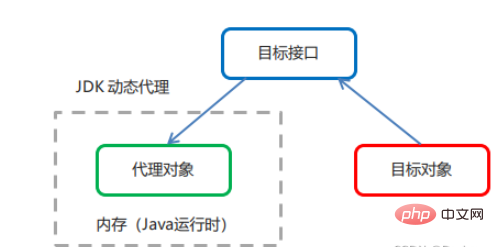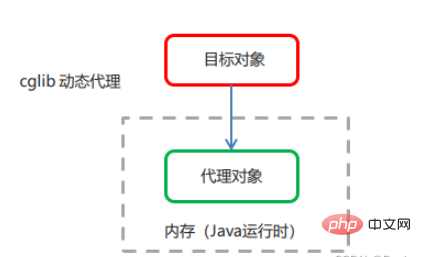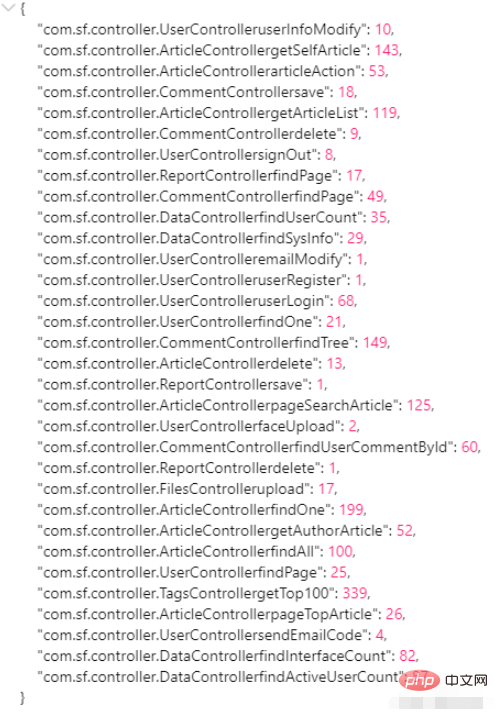How SpringBoot uses AOP to count the number of global interface visits
What is AOP
AOP (Aspect Oriented Programming), which is aspect-oriented programming, is a traditional and maintained technology that realizes program functions through pre-compilation and dynamic proxy during runtime.
The functions and advantages of AOP
Function: During the running of the program, some methods can be functionally enhanced without modifying the source code
Advantages: Reduce duplicate code , improve development efficiency, and facilitate maintenance
Common dynamic proxy technology
jdk proxy: interface-based dynamic proxy technology

cglib Proxy: Dynamic proxy technology based on parent class

AOP related concepts
List item- Target (target object): proxy Target object
Proxy (proxy): After a class is woven into the enhancement by AOP, a resulting proxy class
Joinpoint (connection point ): Connection points are those points that are intercepted. In Spring, these points refer to methods, because Spring only supports method type connection points (methods that can be enhanced are called connection points)
PointCut (pointcut): pointcut It refers to the definition of which Joinpoints we want to intercept
Advice (notification/enhancement): Notification refers to what we need to do after intercepting the Joinpoint is to notify
Aspect (aspect): It is the combination of pointcuts and notifications
Weaving (weaving): The process of applying enhancements to the target object to create a new proxy object. Spring uses dynamic proxy weaving, while AspectJ uses compiler weaving and class loader weaving
implementation
I use annotation-based AOP development here .
Development steps
Add dependencies
<!--引入AOP依赖-->
<dependency>
<groupId>org.springframework.boot</groupId>
<artifactId>spring-boot-starter-aop</artifactId>
</dependency>
<!--AOP-->
<dependency>
<groupId>org.aspectj</groupId>
<artifactId>aspectjrt</artifactId>
<version>1.9.4</version>
</dependency>
<dependency>
<groupId>org.aspectj</groupId>
<artifactId>aspectjweaver</artifactId>
<version>1.9.4</version>
</dependency>
<dependency>
<groupId>cglib</groupId>
<artifactId>cglib</artifactId>
<version>3.2.12</version>
</dependency>Create the target interface and target class (with cut points inside)
Create aspect classes (with enhancement methods inside)
Leave the object creation rights of the target class and aspect class to Spirng
Use annotations to configure the weaving relationship in the aspect class
Enable component scanning and AOP in the configuration file Automatic proxy

#Because my project is a SpringBoot Web project, just enable annotations here.
The following code is the atomic counting class used.
import java.util.concurrent.atomic.AtomicInteger;
public class AtomicCounter {
private static final AtomicCounter atomicCounter = new AtomicCounter();
/**
* 单例,不允许外界主动实例化
*/
private AtomicCounter() {
}
public static AtomicCounter getInstance() {
return atomicCounter;
}
private static AtomicInteger counter = new AtomicInteger();
public int getValue() {
return counter.get();
}
public int increase() {
return counter.incrementAndGet();
}
public int decrease() {
return counter.decrementAndGet();
}
// 清零
public void toZero(){
counter.set(0);
}
}The following code is the global interface monitoring implemented.
I simply use Redis for caching in the project, and you can see all Redis-related operations.
Use @Before to configure pre-notification. Specifies that the enhanced method is executed before the pointcut method.
Use @ @AfterReturning to configure post notification. Specifies that the enhanced method is executed after the pointcut method.
Use @ @AfterThrowing to configure exception throwing notifications. Specifies that the enhanced method is executed when an exception occurs.
@Component
@Aspect
public class GlobalActuator {
private static final Logger log = LoggerFactory.getLogger(GlobalActuator.class);
@Resource
private StringRedisTemplate stringRedisTemplate;
ThreadLocal<Long> startTime = new ThreadLocal<>();
ConcurrentHashMap<Object, Object> countMap = new ConcurrentHashMap<Object, Object>();
/**
* 匹配控制层层通知 这里监控controller下的所有接口
*/
@Pointcut("execution(* com.sf.controller.*Controller.*(..))")
private void controllerPt() {
}
/**
* 在接口原有的方法执行前,将会首先执行此处的代码
*/
@Before("com.sf.actuator.GlobalActuator.controllerPt()")
public void doBefore(JoinPoint joinPoint) throws Throwable {
startTime.set(System.currentTimeMillis());
//获取传入目标方法的参数
Object[] args = joinPoint.getArgs();
}
/**
* 只有正常返回才会执行此方法
* 如果程序执行失败,则不执行此方法
*/
@AfterReturning(returning = "returnVal", pointcut = "com.sf.actuator.GlobalActuator.controllerPt()")
public void doAfterReturning(JoinPoint joinPoint, Object returnVal) throws Throwable {
Signature signature = joinPoint.getSignature();
String declaringName = signature.getDeclaringTypeName();
String methodName = signature.getName();
String mapKey = declaringName + methodName;
// 执行成功则计数加一
int increase = AtomicCounter.getInstance().increase();
HttpServletRequest request = ((ServletRequestAttributes) RequestContextHolder.getRequestAttributes()).getRequest();
synchronized (this) {
//在项目启动时,需要在Redis中读取原有的接口请求次数
if (countMap.size() == 0) {
JSONObject jsonObject = RedisUtils.objFromRedis(StringConst.INTERFACE_ACTUATOR);
if (jsonObject != null) {
Set<String> strings = jsonObject.keySet();
for (String string : strings) {
Object o = jsonObject.get(string);
countMap.putIfAbsent(string, o);
}
}
}
}
// 如果此次访问的接口不在countMap,放入countMap
countMap.putIfAbsent(mapKey, 0);
countMap.compute(mapKey, (key, value) -> (Integer) value + 1);
synchronized (this) {
// 内存计数达到30 更新redis
if (increase == 30) {
RedisUtils.objToRedis(StringConst.INTERFACE_ACTUATOR, countMap, Constants.AVA_REDIS_TIMEOUT);
//删除过期时间
stringRedisTemplate.persist(StringConst.INTERFACE_ACTUATOR);
//计数器置为0
AtomicCounter.getInstance().toZero();
}
}
//log.info("方法执行次数:" + mapKey + "------>" + countMap.get(mapKey));
//log.info("URI:[{}], 耗费时间:[{}] ms", request.getRequestURI(), System.currentTimeMillis() - startTime.get());
}
/**
* 当接口报错时执行此方法
*/
@AfterThrowing(pointcut = "com.sf.actuator.GlobalActuator.controllerPt()")
public void doAfterThrowing(JoinPoint joinPoint) {
HttpServletRequest request = ((ServletRequestAttributes) RequestContextHolder.getRequestAttributes()).getRequest();
log.info("接口访问失败,URI:[{}], 耗费时间:[{}] ms", request.getRequestURI(), System.currentTimeMillis() - startTime.get());
}
}The Controller layer code is given here.
@GetMapping("/interface/{intCount}")
@ApiOperation(value = "查找接口成功访问次数(默认倒序)")
public Result<List<InterfaceDto>> findInterfaceCount(
@ApiParam(name = "intCount", value = "需要的接口数") @PathVariable Integer intCount
) {
HashMap<String, Integer> hashMap = new HashMap<>();
JSONObject jsonObject = RedisUtils.objFromRedis(StringConst.INTERFACE_ACTUATOR);
if (jsonObject != null) {
Set<String> strings = jsonObject.keySet();
for (String string : strings) {
Integer o = (Integer) jsonObject.get(string);
hashMap.putIfAbsent(string, o);
}
}
//根据value倒序
Map<String, Integer> sortedMap = hashMap.entrySet().stream().sorted(Collections.reverseOrder(Map.Entry.comparingByValue()))
.collect(Collectors.toMap(Map.Entry::getKey, Map.Entry::getValue, (e1, e2) -> e1, LinkedHashMap::new));
//返回列表
List<InterfaceDto> resultList = new ArrayList<>();
//排序后中的map中所有的key
Object[] objects = sortedMap.keySet().toArray();
for (int i = 0; i < intCount; i++) {
InterfaceDto interfaceDto = new InterfaceDto();
interfaceDto.setName((String) objects[i]);
interfaceDto.setCount(sortedMap.get((String) objects[i]));
resultList.add(interfaceDto);
}
return Result.success(resultList);
}After the project has been running for a period of time, you can see the number of requests for the interface in Redis.

The final rendering of Web is as follows:

The above is the detailed content of How SpringBoot uses AOP to count the number of global interface visits. For more information, please follow other related articles on the PHP Chinese website!

Hot AI Tools

Undresser.AI Undress
AI-powered app for creating realistic nude photos

AI Clothes Remover
Online AI tool for removing clothes from photos.

Undress AI Tool
Undress images for free

Clothoff.io
AI clothes remover

Video Face Swap
Swap faces in any video effortlessly with our completely free AI face swap tool!

Hot Article

Hot Tools

Notepad++7.3.1
Easy-to-use and free code editor

SublimeText3 Chinese version
Chinese version, very easy to use

Zend Studio 13.0.1
Powerful PHP integrated development environment

Dreamweaver CS6
Visual web development tools

SublimeText3 Mac version
God-level code editing software (SublimeText3)

Hot Topics
 1386
1386
 52
52
 How Springboot integrates Jasypt to implement configuration file encryption
Jun 01, 2023 am 08:55 AM
How Springboot integrates Jasypt to implement configuration file encryption
Jun 01, 2023 am 08:55 AM
Introduction to Jasypt Jasypt is a java library that allows a developer to add basic encryption functionality to his/her project with minimal effort and does not require a deep understanding of how encryption works. High security for one-way and two-way encryption. , standards-based encryption technology. Encrypt passwords, text, numbers, binaries... Suitable for integration into Spring-based applications, open API, for use with any JCE provider... Add the following dependency: com.github.ulisesbocchiojasypt-spring-boot-starter2. 1.1Jasypt benefits protect our system security. Even if the code is leaked, the data source can be guaranteed.
 How SpringBoot integrates Redisson to implement delay queue
May 30, 2023 pm 02:40 PM
How SpringBoot integrates Redisson to implement delay queue
May 30, 2023 pm 02:40 PM
Usage scenario 1. The order was placed successfully but the payment was not made within 30 minutes. The payment timed out and the order was automatically canceled. 2. The order was signed and no evaluation was conducted for 7 days after signing. If the order times out and is not evaluated, the system defaults to a positive rating. 3. The order is placed successfully. If the merchant does not receive the order for 5 minutes, the order is cancelled. 4. The delivery times out, and push SMS reminder... For scenarios with long delays and low real-time performance, we can Use task scheduling to perform regular polling processing. For example: xxl-job Today we will pick
 How to use Redis to implement distributed locks in SpringBoot
Jun 03, 2023 am 08:16 AM
How to use Redis to implement distributed locks in SpringBoot
Jun 03, 2023 am 08:16 AM
1. Redis implements distributed lock principle and why distributed locks are needed. Before talking about distributed locks, it is necessary to explain why distributed locks are needed. The opposite of distributed locks is stand-alone locks. When we write multi-threaded programs, we avoid data problems caused by operating a shared variable at the same time. We usually use a lock to mutually exclude the shared variables to ensure the correctness of the shared variables. Its scope of use is in the same process. If there are multiple processes that need to operate a shared resource at the same time, how can they be mutually exclusive? Today's business applications are usually microservice architecture, which also means that one application will deploy multiple processes. If multiple processes need to modify the same row of records in MySQL, in order to avoid dirty data caused by out-of-order operations, distribution needs to be introduced at this time. The style is locked. Want to achieve points
 How to solve the problem that springboot cannot access the file after reading it into a jar package
Jun 03, 2023 pm 04:38 PM
How to solve the problem that springboot cannot access the file after reading it into a jar package
Jun 03, 2023 pm 04:38 PM
Springboot reads the file, but cannot access the latest development after packaging it into a jar package. There is a situation where springboot cannot read the file after packaging it into a jar package. The reason is that after packaging, the virtual path of the file is invalid and can only be accessed through the stream. Read. The file is under resources publicvoidtest(){Listnames=newArrayList();InputStreamReaderread=null;try{ClassPathResourceresource=newClassPathResource("name.txt");Input
 How to implement Springboot+Mybatis-plus without using SQL statements to add multiple tables
Jun 02, 2023 am 11:07 AM
How to implement Springboot+Mybatis-plus without using SQL statements to add multiple tables
Jun 02, 2023 am 11:07 AM
When Springboot+Mybatis-plus does not use SQL statements to perform multi-table adding operations, the problems I encountered are decomposed by simulating thinking in the test environment: Create a BrandDTO object with parameters to simulate passing parameters to the background. We all know that it is extremely difficult to perform multi-table operations in Mybatis-plus. If you do not use tools such as Mybatis-plus-join, you can only configure the corresponding Mapper.xml file and configure The smelly and long ResultMap, and then write the corresponding sql statement. Although this method seems cumbersome, it is highly flexible and allows us to
 Comparison and difference analysis between SpringBoot and SpringMVC
Dec 29, 2023 am 11:02 AM
Comparison and difference analysis between SpringBoot and SpringMVC
Dec 29, 2023 am 11:02 AM
SpringBoot and SpringMVC are both commonly used frameworks in Java development, but there are some obvious differences between them. This article will explore the features and uses of these two frameworks and compare their differences. First, let's learn about SpringBoot. SpringBoot was developed by the Pivotal team to simplify the creation and deployment of applications based on the Spring framework. It provides a fast, lightweight way to build stand-alone, executable
 How SpringBoot customizes Redis to implement cache serialization
Jun 03, 2023 am 11:32 AM
How SpringBoot customizes Redis to implement cache serialization
Jun 03, 2023 am 11:32 AM
1. Customize RedisTemplate1.1, RedisAPI default serialization mechanism. The API-based Redis cache implementation uses the RedisTemplate template for data caching operations. Here, open the RedisTemplate class and view the source code information of the class. publicclassRedisTemplateextendsRedisAccessorimplementsRedisOperations, BeanClassLoaderAware{//Declare key, Various serialization methods of value, the initial value is empty @NullableprivateRedisSe
 How to get the value in application.yml in springboot
Jun 03, 2023 pm 06:43 PM
How to get the value in application.yml in springboot
Jun 03, 2023 pm 06:43 PM
In projects, some configuration information is often needed. This information may have different configurations in the test environment and the production environment, and may need to be modified later based on actual business conditions. We cannot hard-code these configurations in the code. It is best to write them in the configuration file. For example, you can write this information in the application.yml file. So, how to get or use this address in the code? There are 2 methods. Method 1: We can get the value corresponding to the key in the configuration file (application.yml) through the ${key} annotated with @Value. This method is suitable for situations where there are relatively few microservices. Method 2: In actual projects, When business is complicated, logic




